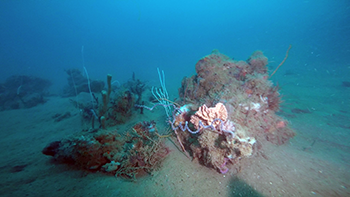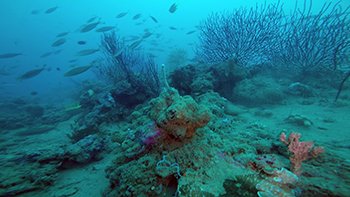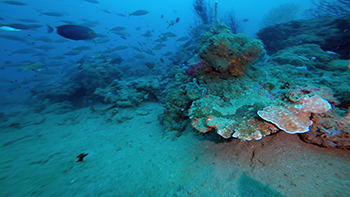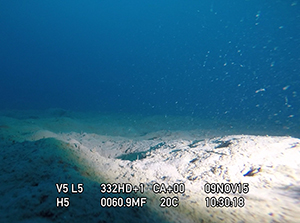 A coral mapping project conducted in November 2015 detailed underwater surveys and mapping in the shallow euphotic reefs and deep mesophotic reefs of Abra de Ilog, Occidental Mindoro.
A coral mapping project conducted in November 2015 detailed underwater surveys and mapping in the shallow euphotic reefs and deep mesophotic reefs of Abra de Ilog, Occidental Mindoro.
Euphotic reef communities are found at 1–30 m depth and have been extensively surveyed by many marine researchers and conservation managers using conventional survey methods.
On the other hand, the mesophotic area or the ‘twilight zone’ found at 30 to 150 meters depth, is among the least studied environment due to the technical limitations and personal risks involved in deep surveys.
The Geophysical Coral Mapping, implemented by the University of the Philippines-Marine Science Institute (UP-MSI) and funded by the Philippine Council for Agriculture, Aquatic and Natural Resources Research and Development of the Department of Science and Technology (DOST-PCAARRD), attempts to address the knowledge gaps, and improve the Philippines' technical capability in mesophotic research. The project aims to document the occurrence and biodiversity of mesophotic reefs, provide detailed seafloor maps and hydrodynamic models.
Abra de Ilog is among the first sites in the Philippines that has been surveyed quantitatively for its mesophotic coral reefs and fish communities. Among others, the survey found a total of 66 fish species from 15 families during diver-based surveys, of which 41 species from 13 families were found in the euphotic zone and 45 species from 15 families were seen in the upper mesophotic zone.
 A total of 39 coral genera was also recorded, all of which were found in the euphotic zone, while 25 genera are found in the mesophotic zone. The surveyed reefs were severely disturbed by sedimentation. Many dead and live corals were covered in silt. Live hard coral cover in euphotic zone was poor with 21% cover, and even more so in the mesophotic zone with only 4%. Dead coral cover was 29% in the euphotic and 26% in the mesophotic zone. This area is surprisingly biodiverse, considering the poor coral condition, high turbidity, and heavy siltation in the area. These indicate that the mesophotic reefs should be included in conservation priorities and that they are also vulnerable to large-scale impacts like sedimentation.
A total of 39 coral genera was also recorded, all of which were found in the euphotic zone, while 25 genera are found in the mesophotic zone. The surveyed reefs were severely disturbed by sedimentation. Many dead and live corals were covered in silt. Live hard coral cover in euphotic zone was poor with 21% cover, and even more so in the mesophotic zone with only 4%. Dead coral cover was 29% in the euphotic and 26% in the mesophotic zone. This area is surprisingly biodiverse, considering the poor coral condition, high turbidity, and heavy siltation in the area. These indicate that the mesophotic reefs should be included in conservation priorities and that they are also vulnerable to large-scale impacts like sedimentation.
Mesophotic reefs also differ from the more familiar shallower reefs in many ways. Unlike the shallow reefs that were dominated by boulder-like massive corals such as Porites and Favia (in other sites, also branching corals), the upper mesophotic was dominated by flattened encrusting forms such as Leptoseris and foliose forms such as Echinophyllia. There are more gorgonians, black corals, sponges, invertebrates, and fishes in the mesophotic that remain largely undocumented.
 Despite poor reef conditions in the site, overall fish community biomass was high and averaged 54 metric ton per square kilometer. The mesophotic zone had six times more fish biomass than the euphotic zone (92.5 mt/km2 vs. 15.5 mt/km2). Target fishes and benthic carnivores were particularly more abundant in the mesophotic. Starting at the edge of the forereef, the most dominant fish species is the Banana Fusilier (Pterocaesio pisang). At 30-35 m deep, Golden Damselfish (Amblyglyphidodon aureus) occurred in schools along with smaller groups of Squarespot Anthias (Pseudanthias pleurotaenia), which are iconic species in the upper boundary of many mesophotic reefs in the Philippines. A flurry of wrasse, surgeonfish, unicornfish, angelfish, and butterflyfish species also occurred. However, the lack of large predators like the groupers, snappers, trevallies, and sharks suggests overfishing that places selective pressure on these high-value fishes.
Despite poor reef conditions in the site, overall fish community biomass was high and averaged 54 metric ton per square kilometer. The mesophotic zone had six times more fish biomass than the euphotic zone (92.5 mt/km2 vs. 15.5 mt/km2). Target fishes and benthic carnivores were particularly more abundant in the mesophotic. Starting at the edge of the forereef, the most dominant fish species is the Banana Fusilier (Pterocaesio pisang). At 30-35 m deep, Golden Damselfish (Amblyglyphidodon aureus) occurred in schools along with smaller groups of Squarespot Anthias (Pseudanthias pleurotaenia), which are iconic species in the upper boundary of many mesophotic reefs in the Philippines. A flurry of wrasse, surgeonfish, unicornfish, angelfish, and butterflyfish species also occurred. However, the lack of large predators like the groupers, snappers, trevallies, and sharks suggests overfishing that places selective pressure on these high-value fishes.
The Remotely Deployed Video system or RDV (also named in honor of the late Dr. Ronald D. Villanueva, a renowned Filipino coral reef scientist who was part of the project) was test deployed in the site. It is a drop-type camera system that the project is developing as an alternative, less costly method to gather fish and coral data from the safety of the boat. A downward-facing camera recorded benthic cover, whereas four other cameras recorded fish assemblages. Further design improvements are needed to improve stability and ease of deployment, among others.
Finally, Abra de Ilog also became a test site for semi-quantitative surveys and explorations in the mesophotic zone using a remotely operated vehicle or ROV. A subsection of the upper mesophotic zone from 30–60 m was observed in one of the 13 ROV missions. The reefscape at 30–40 m were as described above, with the addition of sea fans, sea whips, soft corals, black corals, calcareous algae, and sponges. Scleractinians, particularly whisker (Duncanopsammia axifuga) and chalice corals (Echinophyllia sp.) were few and far between. Large schools of fusiliers were found at 40 m. Bigeye trevally (Caranx sexfasciatus) and Silver Bigeye (Priacanthus blochii) were found around a patch at 46 m depth. At 47 to 61 m, no corals or fishes were found. The ROV could go as deep as 150 m but the seafloor was flat with mostly fine, silty sand with burrows.
Building on the initial success of the surveys in Abra de Ilog, the project team surveyed two other remote sites: Apo Reef Natural Park (Occidental Mindoro), and Patnanungan (Quezon). The project hopes these pioneering research efforts on mesophotic reefs of the Philippines will contribute to new knowledge on mesophotic reefs, spread awareness of their ecological and socio-economic importance, and help refine national policies on coral reef and fisheries management.








